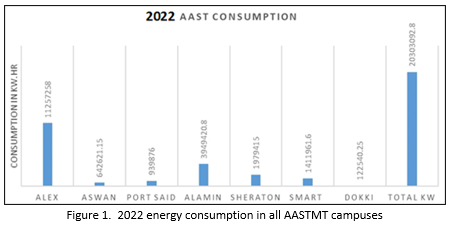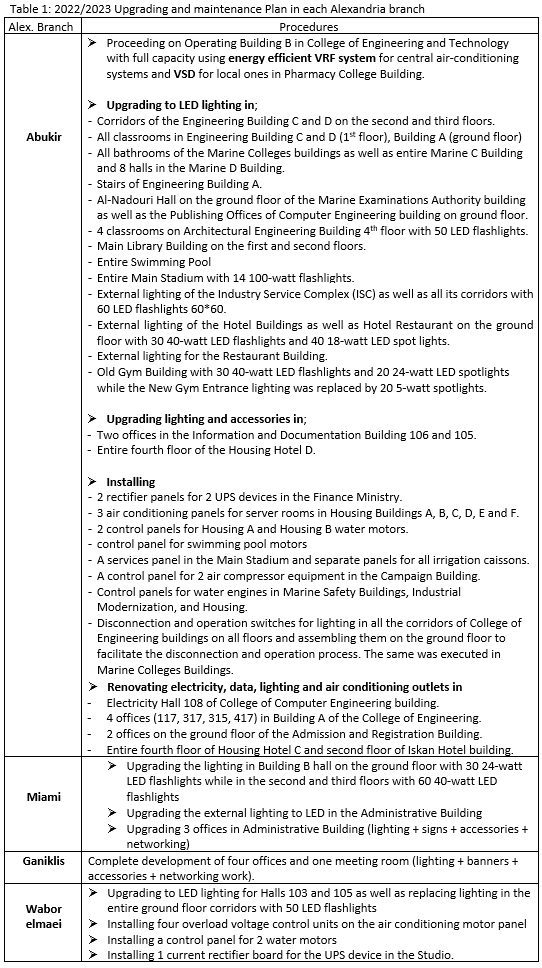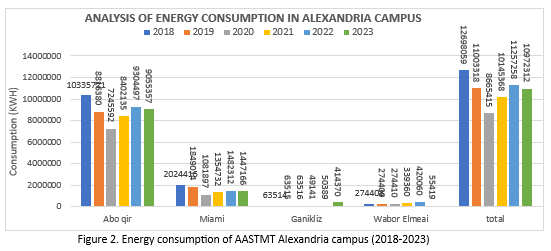 Explore PDF (2023-2024)
Explore PDF (2023-2024)
AASTMT undergoes energy reviews to identify areas where energy waste is highest.
In each AASTMT campus, all sources of energy consumption across the campus (including buildings, dormitories, labs, cafeterias, recreational facilities, etc.) are mapped out and local regular online monitoring at each facility is executed. Data from these local energy meters are used to track energy use in each building during different times (day/night, weekdays/weekends, and seasonal variations) to identify periods of high and low demand. Calculate the difference between peak energy consumption and off-peak consumption will identify potential overuse or unnecessary use. Hence, in each annual plan, buildings of high energy usage and wastage will be selected for internal audits to identify reasons of energy inefficiencies and take suitable measures to reduce and rationalize energy consumption in such places (upgrading and renovation towards higher energy efficiency, maintenance and internal energy audits, enhancing awareness for energy saving and conservation, …..etc.). These measures are carried out as per standards listed in “AASTMT Approach of Establishing, Operating and Maintaining Buildings towards Achieving Sustainable Development Goals at All Academy Headquarters”.
AASTMT Buildings' Approach towards SDGs-pdf
AASTMT Buildings' Approach towards Achieving SDGs on AASTMT webpage
2023/2024 Procedures for energy wastage identification and reduction
For, 2023 energy consumption insights in different AASTMT campuses, as shown in Fig. 1, it is clear that Alexandria branch experience highest energy consumption and in turn highest energy wastage. This is related to the fact that Alexandria branch features multiple campuses, oldest infrastructure and largest number of staff and students, compared to other AAST campuses. Hence, in AASTMT 2024 procedures, towards wastage identification, energy saving and buildings’ renovation to higher energy efficiency, are applied primarily to Alexandria campus as discussed in details in AASTMT 2024 Plan towards Clean Sustainable Energy. The effect of these procedures on energy consumption and wastage reduction in 2024 is detailed in AASTMT 2023/2024 Energy Progress Report

2024 AASTMT measures towards energy wastage reduction
In each Alexandria branch, data from local meters at each building is collected to analyze energy use of this building during different times and identify its subjection to energy wastage or energy inefficiencies. In 2024, buildings with highest wastage were selected for internal audits and the following measures were taken towards these building;
- Prioritizing BMS tuning (scheduling, set-points, and alarms), targeting HVAC, and light controls in high-use spaces.
- Implementing power factor correction panels as well as upgrading electrical outlets and accessories.
- Determining load priorities for efficient energy management
- Completing the replacement of lighting lamps and working with LED lamps as was planned for 2024, where replacement rate rises to more than 95% leading to a significant reduction in electricity consumption.
- Increasing the operating efficiency of many air-conditioning systems (energy-efficient HVAC systems) by efficient drive control
- Applying motion-sensor lighting in common areas and energy-saving modes for conditioners to increase building efficiencies during unoccupied periods
- Identify older or inefficient equipment, to be replaced
- Regular electrical maintenance procedures.
- Continuous checking for unnecessary use of energy where lighting, air conditioners or computers are left on even if the place is unoccupied.
- Solar heaters have been installed by the end of 2023 to replace electric heaters in students’ dorms – Alexandria campus- Abukir branch and put into action in 2024, besides the already applied ones in the Pharmacy college.
- Full utilization of university photovoltaic infrastructure in AASTMT Alex. branch in 2024 where a grid-tied 50kW solar power station with net metering system is fully operated in the Seventh Engineering Building in Alexandria campus- Abukir
- Spreading instructions and directions towards energy saving and minimizing energy wastage as per the letter addressed to all AASTMT campuses from AASTMT president.
Letter addressed to all AASTMT institutes from AASTMT president regarding energy saving
- Many initiatives and campaigns are taking place in Alexandria campus to increase awareness about energy wastage and promote energy savings.
Related Events on AASTMT webpage.
Noting that detailed renovations and maintenance procedures, for high energy wastage buildings, in Alexandria different branches (Abukir, Miami, Wabour elmaei) are detailed in AASTMT 2024 Plan towards Clean Sustainable Energy, stating each building number and renovation procedure as summarized below.
First: Abou Qir Branch
- Upgrading lighting at the new gym entrance with 20 spotlights (5 W).
- Upgrading electrical outlets, data points, and lighting on the entire 4th floor of Housing Hotel C.
- Upgrading electrical outlets and accessories on the entire 2nd floor of Housing Hotel E.
- Upgrading lighting in 4 classrooms on the 4th floor of the Architecture Engineering Building with 50 LED fixtures.
- Upgrading lighting in all corridors of Engineering Buildings C and D to LED with 100 fixtures.
- Upgrading lighting in 8 classrooms of Building D (Marine) with 40 LED fixtures.
- Installing 2 power factor correction panels for 2 UPS units in the Financial Affairs Building.
- Installing 2 control panels for water pumps in Housing A and Housing B.
- Upgrading lighting in classrooms on the 3rd and 4th floors of Engineering Building D with 100 LED fixtures.
- Upgrading lighting in classrooms on the 3rd and 4th floors of Engineering Building C with 100 LED fixtures.
- Upgrading all lighting in the main restaurant of Housing Hotel E with 50 LED fixtures.
- Upgrading lighting in 4 classrooms of the Preparatory Studies Building with 60 LED fixtures.
- Upgrading lighting, outlets, and accessories on the 3rd and 4th floors of Housing Hotel C.
- Upgrading lighting, outlets, and accessories on the 1st floor of Housing Hotel D.
- Installing 7 control panels for 7 irrigation system stations.
- Installing 1 power factor correction panel for the Civil Machinery Lab in Engineering Building D.
- Installing 1 power factor correction panel for the paper-cutting machine in the Printing Building.
- Upgrading outdoor lighting at Smart Cafeteria with 6 façade LED lights (100 W).
- Upgrading lighting in the ground-floor classroom of Engineering Building G with 30 LED fixtures.
- Upgrading lighting, outlets, and accessories on the 2nd and 3rd floors of the Industrial Modernization Building.
- Upgrading lighting, outlets, and accessories in Hall 02 of the Preparatory Studies Building.
- Installing 1 power factor correction panel for a UPS device in ground floor of Financial Affairs Building.
- Upgrading outdoor rooftop lighting of Eng. Faculty Buildings with 6 façade LED lights (200 W).
- Upgrading outdoor rooftop lighting of the Maintenance Building with 6 façade LED lights (200 W).
- Upgrading 18 sub-distribution panels (power + lighting) in the Engineering Faculty Buildings.
- Upgrading 6 sub-panels (power + lighting) in Housing Building D.
- Upgrading the main power and lighting panel feeding the restaurant of Housing Hotel D.
- Upgrading 2 panels (power + lighting) feeding the Marine Safety Building vestibule.
- Upgrading the hangar power and lighting panel of the Technicians’ Building.
- Upgrading the Maintenance Building’s power and lighting panel.
- Upgrading all 2nd floor offices of Engineering Building A (lighting + outlets + accessories).
- Upgrading 4 classrooms on the 2nd, 3rd, and 4th floors of the Computers Faculty (lighting + outlets + accessories).
- Upgrading corridor lighting throughout Engineering Building G with 300 LED fixtures.
- Upgrading lighting in 4 classrooms of Engineering Building G with 60 LED fixtures.
- Upgrading lighting in 6 classrooms of the IMO Building with 80 LED fixtures.
- Installing 2 control panels for irrigation pumps of the main field and restaurant, each 3 HP.
- Upgrading pool lighting in the Marine Safety Building with 4 façade LED lights (200 W).
- Upgrading the second phase of low-voltage panels at the main distribution station.
- Upgrading room lighting in Housing A and Housing B with 180 LED fixtures.
- Upgrading bathroom lighting in Housing A and B with 60 LED spotlights.
- Installing a service panel at the Engineering Faculty field for temporary electrical connections during events.
- Upgrading 2 control panels for the water desalination plant at the main restaurant.
- Upgrading the fire alarm panel in the Admissions and Registration Building.
- Installing a power factor correction panel for a UPS in the ground floor of the Financial Affairs Building.
- Installing an alternating control panel for water pumps in Engineering Building G.
Second: Miami Branch
- Upgrading lighting on the ground floor of the main library and Building A classrooms with 50 LED fixtures (40 W).
- Upgrading rooftop lighting of Buildings A and C to LED with 6 façade fixtures (200 W).
- Upgrading 6 administrative offices on the ground floor of Building A (lighting + outlets + accessories).
- Upgrading 3 classrooms on the 3rd floor of the Administrative Building (lighting + outlets + accessories).
- Upgrading lighting in 4 classrooms of Building A with 40 LED fixtures.
- Upgrading outdoor lighting of the Administrative Building and Building B with 40 spotlights (6 W).
- Upgrading landscape lighting with 20 lighting poles.
- Installing a service panel at the International School playground for event and occasion power connections.
- Upgrading interior lighting of the new gym.
- Installing a separate power panel for the new gym.
Third: Wabour El-Maya Branch
- Upgrading corridor lighting on the ground floor to LED with 50 fixtures.
- Installing 1 power factor correction panel for a UPS in the Studio.
- Upgrading corridor lighting on the ground floor to LED with 50 fixtures (duplicate task confirmed).
- Installing 1 control panel for 2 water pumps (3 HP).
- Upgrading lighting in 6 classrooms with 50 fixtures.
- Upgrading lighting in ground-floor corridors and 8 classrooms with 50 spotlights (24 W).
- Upgrading lighting in classrooms and corridors on the 1st and 2nd floors with 30 spotlights (24 W).
Validation of 2024 AASTMT measures towards energy wastage reduction
To evaluate AASTMT procedures towards energy saving and wastage reduction in Alexandria campus, energy consumption in the campus different branches is analyzed in details within the period (2018-2023) as shown in Figure 2 and detailed in AASTMT 2024 Energy and Carbon Insights
These renewal, upgrading, and control efforts in different campuses of AASTMT Alexandria branch have resulted in total electricity savings in 2024 of 474,289 kWh from 2023 as shown in Table 1 and given by 2024 Energy Conservation Report. This verifies the effectiveness of AASTMT plan and measures towards energy efficiency and saving in its entire Alexandria campuses in 2024.
2024 Buildings Upgrading and Energy Conservation Report in AASTMT Alex. Campuses
Table1: Electrical Energy Savings in 2024 in AASTMT Alexandria Campuses
|
Year
|
Lighting (LED) Savings
|
Irrigation Savings
|
Air Conditioning Savings
|
Motors and Equipment Savings
|
Total Savings
|
|
2024
|
124,816 kWh
|
124,816 kWh
|
144,420 kWh
|
80,237 kWh
|
474,289 kW
|
For further validation to annual energy saving efforts in AASTMT-Alex. campuses, Fig. 2 shows energy usage in Alex. Campuses from 2022 till 2024. It is clear that following the yearly renovation and wastage minimization measures planned for different AASTMT Alexandria buildings, notable energy savings are achieved in 2023 by 2.5% from 2022 resulting in energy usage of 10,972,312 kWh and a further significant decrease in 2024 by 4.32% from 2023, achieving energy consumption of 10,498,097 kWh.

Figure 2. Electrical Energy consumption in kWh of AASTMT Alexandria campus (2022-2024)
2022/2023 Procedures for Energy Wastage Identification and Reduction
For, 2022 energy consumption insights in different AASTMT campuses, AASTMT 2022/2023 Insights, it was found that Alexandria campus experience highest energy consumption, as shown in Figure 1, and in turn highest energy wastage. This is related to the fact that Alexandria campus features multiple branches, oldest infrastructure and largest number of staff and students, compared to other AAST campuses. Hence, in AASTMT 2022/2023 procedures, towards wastage identification, energy saving and buildings’ renovation to higher energy efficiency, are applied primarily to Alexandria campus as discussed in details in AASTMT 2022/2023 Plan towards Clean Sustainable Energy. The effect of these procedures on energy consumption and wastage reduction in 2022/2023 is detailed in AASTMT 2022/2023 Energy Progress Report

2022/2023 AASTMT Procedures
In each Alexandria branch, data from local meters at each building is collected to analyze energy use of this building during different times and identify its subjection to energy wastage or energy inefficiencies. In 2022/2023, buildings with highest wastage were selected for internal audits and the following measures were taken towards these building;
- Determine load priorities for efficient energy management
- Completing the replacement of lighting lamps and working with LED lamps as was planned for 2022/2023, where replacement rate rises to more than 95% leading to a significant reduction in electricity consumption.
- Increasing the operating efficiency of many air-conditioning systems (energy-efficient HVAC systems)
- Applying motion-sensor lighting in common areas and energy-saving modes for conditioners to increase building efficiencies during unoccupied periods
- Identify older or inefficient equipment, to be replaced
- Regular electrical maintenance procedures.
- Continuous checking for unnecessary use of energy where lighting, air conditioners or computers are left on even if the place is unoccupied.
- Full utilization of university photovoltaic infrastructure in 2022 where a solar power station with a capacity of 50 kilowatts is installed in the Seventh Engineering Building in Alexandria campus- Abukir
- Solar heaters have been installed in 2023 to replace electric heaters in students’ dorms – Alexandria campus- Abukir branch as planned in 2022, besides the already applied ones in the Pharmacy college.
- Many initiatives and campaigns are taking place in Alexandria campus to increase awareness about energy wastage and promote energy savings.
Related Events on AASTMT webpage.
Noting that detailed renovations and maintenance procedures, for high energy wastage buildings, in Alexandria different branches (Abukir, Miami, Ganaklis, Wabour elmaei) are detailed in AASTMT 2022/2023 Plan towards Clean Sustainable Energy, stating each building number and renovation procedure as summarized in Table 1.

Energy Consumption Reduction in all Alexandria campus-branches in 2023
To evaluate AASTMT procedures towards energy saving and wastage reduction in Alexandria campus, energy consumption in the campus different branches is analyzed in details within the period (2018-2023) as shown in Figure 2 and detailed in AASTMT 2022/2023 Insights.
It is clear that the maximum consumption was in 2018 with a full load of 12,698,059 kWh before Covid19, then the lowest load in 2020 during Covid 19, then it gradually increased until all the branches returned to their full load in 2022 with a value 11,257,258 kWh, as well as 2023, with a value of 10,972,312 kWh. Note that despite the return of total operation and the increase in expansions and new buildings, there is a decrease in the total load by 13.59%, in 2023 compared to 2018. Moreover, comparing energy consumption in different branches of Alexandria campus in 2022 and 2023, it’s clear that all Alexandria branches featured reduction in energy wastage, which in turn reduced energy consumption in 2023 compared to 2022, with a decrease in total energy consumption in the entire campus’ branches by about 2.5%. This verifies the effectiveness of AASTMT 2022/2023 plan and measures towards wastes identification and buildings selection for higher energy efficiency and saving in AASTMT entire Alexandria campus with all its branches.



